The closed transition transfer switch market is expected to grow from USD 1.2 billion in 2025 to USD 2.4 billion by 2035, registering a 7.3% CAGR and generating an absolute dollar opportunity of USD 1.2 billion. Growth is driven by increasing demand for uninterrupted power supply solutions in commercial, industrial, and critical infrastructure applications, including hospitals, data centers, and manufacturing facilities. Closed transition transfer switches ensure seamless load transfer without interruption, making them essential for facilities requiring high reliability and operational continuity. Advancements in smart switching technology, integration with monitoring systems, and increasing adoption of backup power solutions further support market expansion globally.
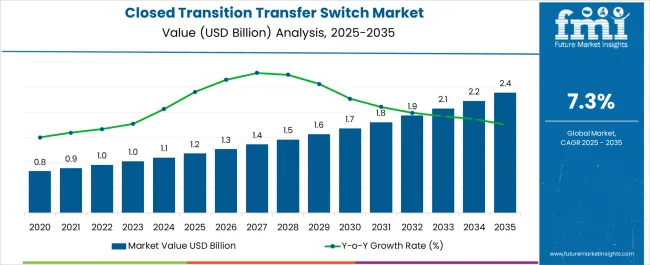
Compound absolute growth analysis highlights the cumulative impact of annual market expansion over the forecast period. From 2025 to 2028, incremental growth is steady, fueled by early adoption in North America and Europe, where regulations, safety standards, and aging electrical infrastructure drive investments. Between 2029 and 2032, the market accelerates as Asia Pacific and Latin America increase infrastructure modernization projects, industrial expansion, and critical facility development, contributing a larger share of the absolute dollar opportunity. From 2033 to 2035, growth continues at a moderate pace, driven primarily by incremental revenue from system upgrades, retrofits, and premium solutions. The USD 1.2 billion opportunity reflects consistent and compounding expansion, demonstrating how both early adoption and later infrastructure-driven acceleration shape the closed transition transfer switch market between 2025 and 2035.
| Metric | Value |
|---|---|
| Closed Transition Transfer Switch Market Estimated Value in (2025 E) | USD 1.2 billion |
| Closed Transition Transfer Switch Market Forecast Value in (2035 F) | USD 2.4 billion |
| Forecast CAGR (2025 to 2035) | 7.3% |
The closed transition transfer switch market is driven by five primary parent markets with specific shares. Commercial buildings lead with 35%, as transfer switches ensure uninterrupted power for offices, malls, and data centers. Industrial facilities contribute 25%, using them to maintain continuous operations in manufacturing, processing, and heavy industries. Healthcare and hospitals account for 15%, requiring reliable power for critical equipment and patient safety. Utilities and energy providers represent 15%, integrating closed transition switches to enhance grid stability and backup systems. Residential and institutional applications hold 10%, supporting uninterrupted electricity for essential services. These segments collectively define global demand.
Recent developments in the closed transition transfer switch market focus on automation, safety, and efficiency. Manufacturers are introducing intelligent switches with real-time monitoring, predictive maintenance, and remote operation capabilities. Enhanced designs reduce transfer times, minimize voltage fluctuations, and improve system reliability during outages. Integration with smart grid infrastructure, renewable energy sources, and backup generators is increasing adoption across commercial and industrial sectors. Growing awareness of power continuity, stringent regulations, and increasing dependence on critical infrastructure are driving deployment. These trends are shaping market growth, promoting innovation, and improving reliability in power transfer solutions worldwide.
The closed transition transfer switch market is expanding steadily, driven by increasing demand for uninterrupted power supply solutions in critical infrastructure, commercial facilities, and industrial operations. The ability of closed transition systems to ensure a seamless power transfer without disruption has reinforced their adoption in sectors where even minimal downtime is unacceptable.
Growing investments in backup power infrastructure, coupled with the rising incidence of power fluctuations, have further stimulated market growth. Technological advancements enhancing switch reliability, safety, and operational life have made them more attractive for high-dependency applications.
Additionally, the integration of monitoring and control systems has improved operational efficiency and reduced maintenance needs. The market outlook remains positive as urbanization, industrialization, and the adoption of smart grid technologies expand, creating sustained demand for high-performance transfer switches capable of delivering stable power transitions in diverse operating conditions.
The closed transition transfer switch market is segmented by operations, switching mechanism, ampere rating, installation, and geographic regions. By operations, closed transition transfer switch market is divided into Manual, Non-automatic, Automatic, and By-pass isolation. In terms of switching mechanism, closed transition transfer switch market is classified into Contactor and Circuit breaker. Based on ampere rating, closed transition transfer switch market is segmented into ≤ 400 Amp, 401 Amp to 1600 Amp, and > 1600 Amp. By installation, closed transition transfer switch market is segmented into Emergency systems, Legally required systems, Critical operations power systems, and Optional standby systems. Regionally, the closed transition transfer switch industry is classified into North America, Latin America, Western Europe, Eastern Europe, Balkan & Baltic Countries, Russia & Belarus, Central Asia, East Asia, South Asia & Pacific, and the Middle East & Africa.
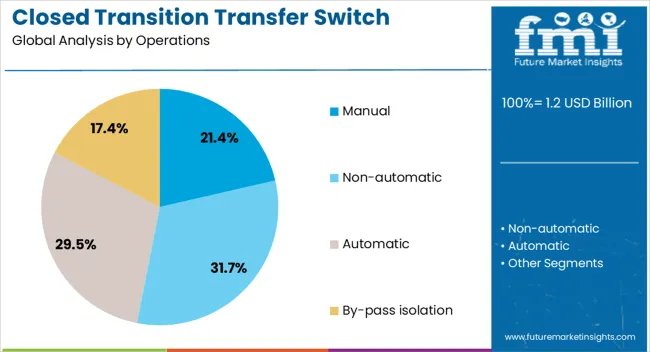
The manual segment holds approximately 21.4% share in the operations category of the closed transition transfer switch market. Its prominence is supported by cost-effectiveness, operational simplicity, and suitability for facilities where switching events are infrequent or scheduled.
Manual systems are preferred in settings where operator oversight is essential to control transition timing and sequence. Their straightforward design reduces the need for complex electronic control systems, minimizing initial investment and maintenance costs.
Despite growing automation trends, manual transfer switches continue to find application in small-scale facilities, backup systems, and sites prioritizing reliability over automation. With continued demand in budget-sensitive markets and low-maintenance environments, the manual segment is expected to retain a stable share in the forecast period.
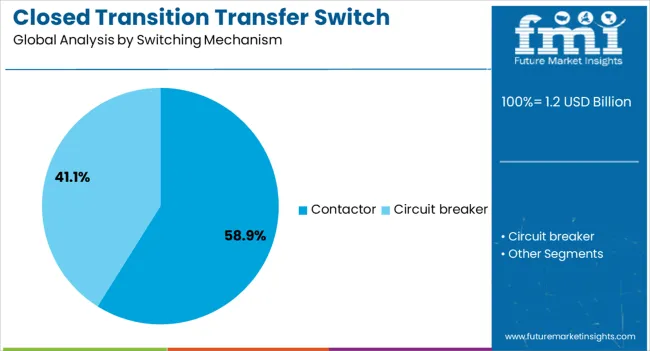
The contactor segment dominates the switching mechanism category, holding approximately 58.9% market share. This leadership is due to the segment’s fast switching capabilities, operational reliability, and adaptability to both low and medium voltage systems.
Contactors facilitate quick power transfers, minimizing voltage dips and maintaining equipment protection. Their compact design, ease of integration, and scalability make them a preferred choice in diverse applications ranging from data centers to manufacturing plants.
Ongoing enhancements in contactor durability and arc suppression technologies have further strengthened their market position. Supported by cost efficiency, wide operational range, and compatibility with automation systems, the contactor segment is anticipated to sustain its leading share in the coming years.
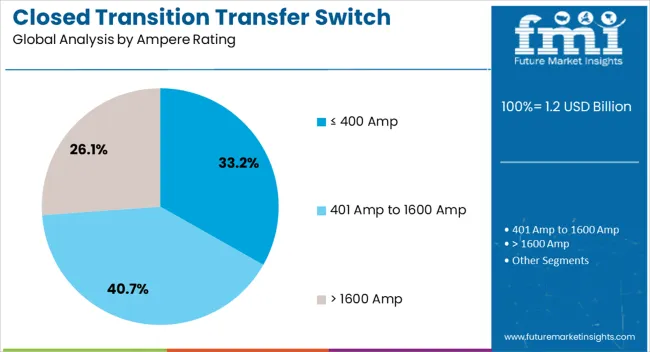
The ≤ 400 Amp segment accounts for approximately 33.2% share of the ampere rating category, driven by its suitability for small to medium-scale commercial, residential, and light industrial applications. This capacity range offers a balance between performance and affordability, making it attractive for localized power distribution systems and backup generators.
The segment’s growth is reinforced by increasing adoption in small data centers, healthcare facilities, and office complexes where critical equipment must remain operational during power transitions.
With rising demand for compact, efficient, and cost-effective power transfer solutions, the ≤ 400 Amp segment is projected to maintain a significant role in the overall market.
The global closed transition transfer switch (CTTS) market is expanding due to rising demand for uninterrupted power supply in commercial, industrial, and critical infrastructure sectors. North America accounted for nearly 35% of the market in 2024, with high adoption in data centers, hospitals, and financial institutions. Europe and Asia Pacific are focusing on industrial plants and renewable energy integration. CTTS ensures seamless transfer between primary and secondary power sources without load interruption. Rising electricity reliability requirements, stricter power quality standards, and industrial automation are driving adoption, creating measurable opportunities for manufacturers and service providers worldwide.
The primary driver of the CTTS market is the need for continuous power in facilities where even brief outages can cause operational or safety risks. Hospitals, data centers, manufacturing plants, and airports require transfer switches capable of instantaneous load transfer without interruption. Closed transition switches allow for seamless transfer with typical switch times under 100 milliseconds, minimizing downtime. North America leads adoption due to high concentration of critical infrastructure, while Europe focuses on integrating CTTS with renewable energy and microgrid setups. Rising industrial automation, increasing demand for mission-critical power reliability, and stricter power quality regulations are key factors propelling market growth in commercial and industrial segments.
Opportunities in the CTTS market are driven by renewable energy adoption, microgrid deployment, and grid modernization projects. Solar and wind installations require precise transfer switches to manage intermittent generation without interrupting critical loads. Microgrid systems, combining battery storage, distributed generation, and backup diesel or gas generators, increasingly rely on CTTS for safe load transfer. North America and Europe are investing heavily in smart grid infrastructure, creating demand for CTTS rated from 400 A to over 3,000 A. Asia Pacific presents growth potential in industrial and telecom sectors. Manufacturers offering modular, compact, and digitally monitored CTTS with integrated SCADA compatibility can capture emerging opportunities globally.
Key trends in the CTTS market include digital monitoring, IoT-enabled control, and standardization for interoperability with renewable and backup power systems. Smart CTTS provide real-time status updates, predictive maintenance alerts, and remote operation, improving uptime by 10–15%. Integration with energy management systems allows operators to coordinate generator dispatch, load balancing, and grid synchronization. Europe leads in adoption of IEC-compliant switches, while North America emphasizes NFPA 70E and UL-certified products. Asia Pacific is expanding industrial adoption with modular, scalable designs for factories and telecom facilities. Advances in low-loss contact materials and compact switchgear layouts are improving efficiency and enabling deployment in space-constrained environments.
Despite advantages, CTTS adoption faces restraints due to high initial investment and technical complexity. Systems with high amperage ratings can cost 20–40% more than open transition switches. Installation requires skilled engineers for correct synchronization, grounding, and integration with generators or utility feeds. Maintenance of moving contacts, digital monitoring modules, and relay settings adds recurring costs. Regulatory compliance across different regions, including UL, IEC, and local power standards, further complicates deployment. Smaller industrial operators may opt for simpler open or delayed transition switches due to cost. Manufacturers must focus on modular, scalable, and easy-to-install designs to overcome these challenges and expand global adoption.
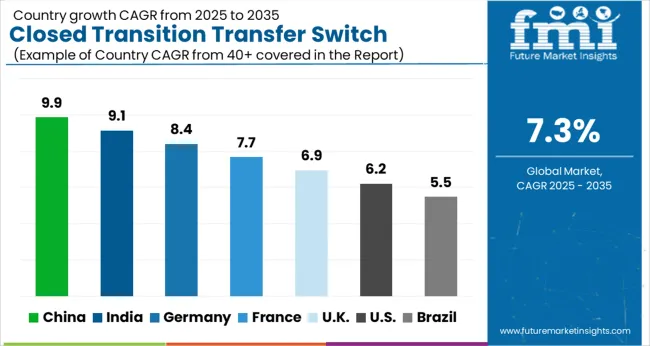
| Countries | CAGR |
|---|---|
| China | 9.9% |
| India | 9.1% |
| Germany | 8.4% |
| France | 7.7% |
| UK | 6.9% |
| USA | 6.2% |
| Brazil | 5.5% |
The closed transition transfer switch market is expected to grow at a global CAGR of 7.3% through 2035, driven by increasing demand for reliable power management, uninterrupted power supply solutions, and industrial automation. China leads at 9.9%, a 1.35× multiple of the global benchmark, supported by BRICS-focused industrial expansion, urban infrastructure projects, and high adoption of smart power systems. India follows at 9.1%, a 1.25× multiple, reflecting growth in commercial and industrial power management solutions. Germany records 8.4%, a 1.15× multiple, shaped by OECD-backed adoption of high-efficiency and safety-compliant power equipment. The United Kingdom posts 6.9%, slightly below the global CAGR, with adoption centered on critical infrastructure and industrial facilities. The United States stands at 6.2%, 0.85× the benchmark, supported by demand in industrial, commercial, and data center applications. BRICS nations lead in volume growth, OECD countries focus on technology and compliance, and ASEAN markets contribute through expanding power infrastructure. This report includes insights on 40+ countries; the top markets are shown here for reference.
The closed transition transfer switch market in China is projected to grow at a CAGR of 9.9%, driven by the modernization of power distribution systems, industrial automation, and growing demand for uninterrupted power in commercial and industrial facilities. Manufacturers such as Siemens, Schneider Electric, and ABB are supplying high-performance switches with advanced control systems for data centers, manufacturing units, and hospitals. Adoption is concentrated in metropolitan and industrial hubs where reliable power supply is critical. Government initiatives promoting smart grids, energy efficiency, and industrial resilience reinforce market growth. Integration with renewable energy systems and backup generators further accelerates deployment.
The closed transition transfer switch market in India is expected to expand at a CAGR of 9.1%, supported by rising demand from industrial, commercial, and infrastructure projects. Indian manufacturers and global players such as ABB, Larsen Toubro, and Schneider Electric are supplying switches designed for high reliability and minimal power interruption. Adoption is focused on power-intensive industries, hospitals, data centers, and large commercial buildings. Government programs promoting smart grids, critical infrastructure resilience, and renewable energy integration are boosting market growth. Investment in automation and backup power solutions is further encouraging adoption of advanced closed transition switches.
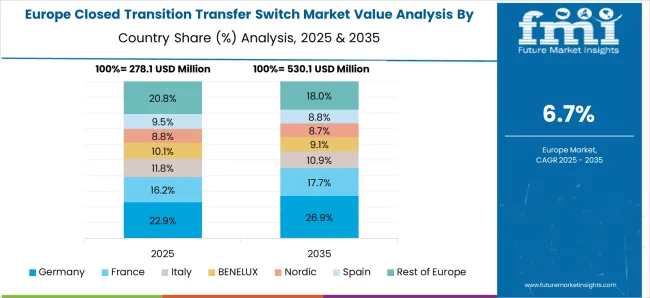
The closed transition transfer switch market in Germany is projected to grow at a CAGR of 8.4%, driven by demand for reliable power in industrial plants, commercial buildings, and critical infrastructure. Leading suppliers including Siemens, ABB, and Eaton are focusing on switches with minimal transfer times, smart monitoring, and energy-efficient designs. Adoption is concentrated in manufacturing hubs, data centers, and hospitals. Government regulations promoting grid reliability, renewable energy integration, and energy efficiency are reinforcing market expansion. Technological trends include remote monitoring, predictive maintenance, and integration with hybrid power systems for uninterrupted operation.
The closed transition transfer switch market in the United Kingdom is forecast to grow at a CAGR of 6.9%, supported by industrial, commercial, and critical infrastructure demand. Suppliers such as Schneider Electric, Eaton, and ABB are providing high-reliability switches designed for minimal downtime and integration with backup generators. Adoption is focused on hospitals, data centers, and manufacturing plants. Government initiatives promoting energy efficiency, smart grids, and critical power resilience are encouraging deployment. Trends include digital control, predictive maintenance, and hybrid power system integration to ensure uninterrupted power supply in urban and industrial regions.
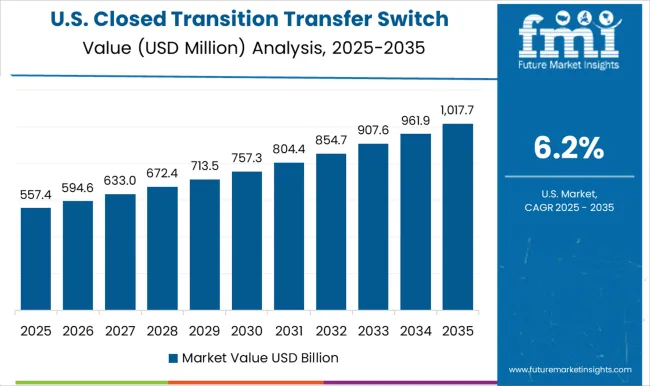
The closed transition transfer switch market in the United States is projected to expand at a CAGR of 6.2%, driven by demand from industrial, commercial, and healthcare facilities requiring continuous power. Companies such as Eaton, Siemens, and Schneider Electric are supplying advanced switches with fast transfer times and digital monitoring capabilities. Adoption is concentrated in data centers, hospitals, and manufacturing units, particularly in regions with high grid variability. Investment in smart grid technologies, renewable integration, and industrial automation reinforces market growth. Focus on reducing downtime and enhancing operational reliability drives deployment of closed transition transfer switches across multiple sectors.
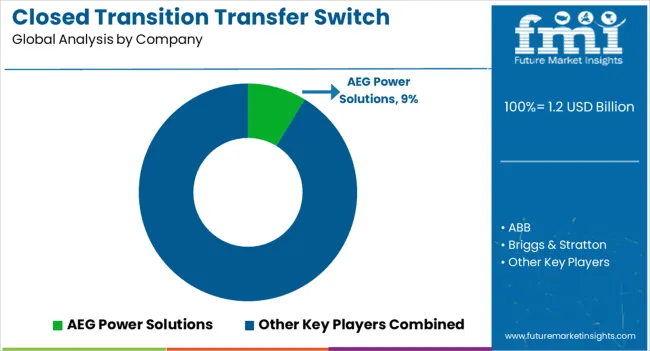
Competition in the closed transition transfer switch market is driven by global electrical equipment providers and specialized manufacturers focusing on reliability, efficiency, and system integration. ABB, Eaton, and AEG Power Solutions lead with advanced switching technology, emphasizing seamless power transfer and minimal downtime. Cummins, Caterpillar, and Generac Power Systems offer scalable solutions for industrial and commercial applications, highlighting durability and compatibility with various power systems in their brochures. Briggs & Stratton, Kohler, and General Electric target both commercial and residential segments, positioning products around compact design, ease of installation, and safety features.
Midwest Electric Products and One Two Three Electric focus on niche applications, offering customizable solutions for specific operational requirements. Brochures showcase technical specifications, testing certifications, and real-world performance metrics, reinforcing trust and reliability. Marketing materials play a pivotal role in competition, with product brochures combining schematics, operational guidelines, and service information to drive buyer decisions. Frequent updates reflect evolving regulatory standards, new product features, and integration capabilities. Larger manufacturers rely on brand reputation and global distribution, while smaller firms emphasize agility, customization, and faster delivery. Market leadership is determined by how effectively brochures communicate operational reliability, technical precision, and long-term value in closed transition transfer switch solutions.
| Item | Value |
|---|---|
| Quantitative Units | USD 1.2 Billion |
| Operations | Manual, Non-automatic, Automatic, and By-pass isolation |
| Switching Mechanism | Contactor and Circuit breaker |
| Ampere Rating | ≤ 400 Amp, 401 Amp to 1600 Amp, and > 1600 Amp |
| Installation | Emergency systems, Legally required systems, Critical operations power systems, and Optional standby systems |
| Regions Covered | North America, Europe, Asia-Pacific, Latin America, Middle East & Africa |
| Country Covered | United States, Canada, Germany, France, United Kingdom, China, Japan, India, Brazil, South Africa |
| Key Companies Profiled | AEG Power Solutions, ABB, Briggs & Stratton, Caterpillar, Cummins, Eaton, General Electric, Generac Power Systems, Kohler, Midwest Electric Products, and One Two Three Electric |
| Additional Attributes | Dollar sales by switch type and end use, demand dynamics across commercial, industrial, and residential power systems, regional trends in backup power adoption, innovation in seamless switching, reliability, and automation, environmental impact of material use and disposal, and emerging use cases in microgrids, data centers, and renewable integration. |
The global closed transition transfer switch market is estimated to be valued at USD 1.2 billion in 2025.
The market size for the closed transition transfer switch market is projected to reach USD 2.4 billion by 2035.
The closed transition transfer switch market is expected to grow at a 7.3% CAGR between 2025 and 2035.
The key product types in closed transition transfer switch market are manual, non-automatic, automatic and by-pass isolation.
In terms of switching mechanism, contactor segment to command 58.9% share in the closed transition transfer switch market in 2025.






Our Research Products

The "Full Research Suite" delivers actionable market intel, deep dives on markets or technologies, so clients act faster, cut risk, and unlock growth.

The Leaderboard benchmarks and ranks top vendors, classifying them as Established Leaders, Leading Challengers, or Disruptors & Challengers.

Locates where complements amplify value and substitutes erode it, forecasting net impact by horizon

We deliver granular, decision-grade intel: market sizing, 5-year forecasts, pricing, adoption, usage, revenue, and operational KPIs—plus competitor tracking, regulation, and value chains—across 60 countries broadly.

Spot the shifts before they hit your P&L. We track inflection points, adoption curves, pricing moves, and ecosystem plays to show where demand is heading, why it is changing, and what to do next across high-growth markets and disruptive tech

Real-time reads of user behavior. We track shifting priorities, perceptions of today’s and next-gen services, and provider experience, then pace how fast tech moves from trial to adoption, blending buyer, consumer, and channel inputs with social signals (#WhySwitch, #UX).

Partner with our analyst team to build a custom report designed around your business priorities. From analysing market trends to assessing competitors or crafting bespoke datasets, we tailor insights to your needs.
Supplier Intelligence
Discovery & Profiling
Capacity & Footprint
Performance & Risk
Compliance & Governance
Commercial Readiness
Who Supplies Whom
Scorecards & Shortlists
Playbooks & Docs
Category Intelligence
Definition & Scope
Demand & Use Cases
Cost Drivers
Market Structure
Supply Chain Map
Trade & Policy
Operating Norms
Deliverables
Buyer Intelligence
Account Basics
Spend & Scope
Procurement Model
Vendor Requirements
Terms & Policies
Entry Strategy
Pain Points & Triggers
Outputs
Pricing Analysis
Benchmarks
Trends
Should-Cost
Indexation
Landed Cost
Commercial Terms
Deliverables
Brand Analysis
Positioning & Value Prop
Share & Presence
Customer Evidence
Go-to-Market
Digital & Reputation
Compliance & Trust
KPIs & Gaps
Outputs
Full Research Suite comprises of:
Market outlook & trends analysis
Interviews & case studies
Strategic recommendations
Vendor profiles & capabilities analysis
5-year forecasts
8 regions and 60+ country-level data splits
Market segment data splits
12 months of continuous data updates
DELIVERED AS:
PDF EXCEL ONLINE
Closed Core Power Transformer Market Size and Share Forecast Outlook 2025 to 2035
Closed Core Transformer Market Size and Share Forecast Outlook 2025 to 2035
Closed Funnel Ampoules Market
Closed System Transfer Devices Market Insights – Industry Trends & Forecast 2024-2034
Enclosed Smokeless Flares Market Size and Share Forecast Outlook 2025 to 2035
Enclosed Waste Gas Flares Market Size and Share Forecast Outlook 2025 to 2035
Enclosed Motor Starter Market Growth – Trends & Forecast 2024-2034
Fully Enclosed Cartons Market Size and Share Forecast Outlook 2025 to 2035
Fully Enclosed 3D Printing Smart Warehouse Market Size and Share Forecast Outlook 2025 to 2035
Automotive Closed Loop Current Transducer Market Size and Share Forecast Outlook 2025 to 2035
2D Transition Metal Carbides Nitrides Market Size and Share Forecast Outlook 2025 to 2035
Open Transition Transfer Switch Market Size and Share Forecast Outlook 2025 to 2035
State Transition Testing Market Size and Share Forecast Outlook 2025 to 2035
Floor Transition Strips Market Analysis - Size, Share, and Forecast Outlook 2025 to 2035
Switchgear for Data Centers Market Size and Share Forecast Outlook 2025 to 2035
Switchrack Assemblies Market Size and Share Forecast Outlook 2025 to 2035
Switching Residential Voltage Regulator Market Size and Share Forecast Outlook 2025 to 2035
Switching Commercial Voltage Regulator Market Size and Share Forecast Outlook 2025 to 2035
Switching Mode Power Supply Market - Growth & Forecast 2025 to 2035
Switched Reluctance Motors Market Growth - Trends & Forecast 2025 to 2035

Thank you!
You will receive an email from our Business Development Manager. Please be sure to check your SPAM/JUNK folder too.
Chat With
MaRIA